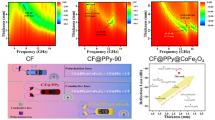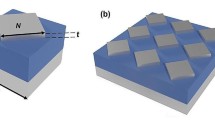Abstract
In recent years, cloaking using materials with negative electric permittivity or magnetic permeability has been studied and researched. It has been demonstrated that covering an object with a cloak having an electric permittivity or magnetic permeability that is negative or less than unity can cause a reduction of the scattering cross-section (SCS) of the object. In this paper, we solve the scattering problem for an object with a single- or multilayer cylindrical cloak and thus obtain the fundamental equations necessary to design such cloaks under two conditions, viz. with and without consideration of the effects of coupling when solving the scattering problem. Using the obtained equations we demonstrate that this technique can indeed reduce the visibility of the object.







Similar content being viewed by others
References
Dolin, L.S.: To the possibility of comparison of three-dimensional electromagnetic systems with nonuniform anisotropic filling. Izvestiya Vuzov Radiofizika 4(5), 964–967 (1961)
Pendry, J.B., Schurig, D., Smith, D.R.: Controlling electromagnetic fields. Science 312, 1780–1782 (2006)
Greenleaf, A., Kurylev, Y., Lassas, M., Uhlmann, G.: Cloaking devices, electromagnetic wormholes, and transformation optics. SIAM Rev. 51(1), 3–33 (2009)
Kerker, M.: Invisible bodies. J. Opt. Soc. Am. 65(4), 376–379 (1975)
Alù, A., Bilotti, F., Vegni, L.: Method of lines numerical analysis of conformal antennas. IEEE Trans. Antennas Propag. 52(6), 1530–1540 (2004)
Alitalo, P., Luukkonen, O., Jylha, L., Venermo, J., Tretyakov, S.A.: Transmission-line networks cloaking objects from electromagnetic fields. IEEE Trans. Antennas Propag. 56(2), 416–424 (2008)
Alitalo, P., Ranvier, S., Vehmas, J., Tretyakov, S.: A microwave transmission-line network guiding electromagnetic fields through a dense array of metallic objects. Metamaterials 2(4), 206–212 (2008)
Alitalo, P., Culhaoglu, A.E., Osipov, A.V., Thurner, S., Kemptner, E., Tretyakov, S.A.: Bistatic scattering characterization of a three-dimensional broadband cloaking structure. J. Appl. Phys. 111(3), 034901–034905 (2012)
Nicorovici, N.A., Milton, G.W., McPhedran, R.C., Botten, L.C.: Quasistatic cloaking of two dimensional polarizable discrete systems by anomalous resonance. Opt. Express 15(10), 6314–6323 (2007)
Nicorovici, N.P., McPhedran, R.V., Enoch, S., Tayeb, G.: Finite wavelength cloaking by plasmonic resonance. New J. Phys. 10(11), 115020 (2008)
Alù, A., Engheta, N.: Achieving transparency with plasmonic and metamaterial coatings. Phys. Rev. E 72(1), 016623 (2005)
Johnson, P.B., Christy, R.W.: Optical constants of the noble metals. Phys. Rev. B 6(12), 4370–4379 (1972)
Chew, H., Kerker, M.: Abnormally low electromagnetic scattering cross sections. J. Opt. Soc. Am. 66(5), 445 (1976)
Alù, A., Engheta, N.: Theory and potentials of multi-layered plasmonic covers for multi-frequency cloaking. New J. Phys. 10, 115036 (2008)
Alù, A., Engheta, N.: Plasmonic materials in transparency and cloaking problems: mechanism, robustness, and physical insights. Opt. Express 15(6), 3318–3332 (2007)
Alù, A., Engheta, N.: Cloaking and transparency for collections of particles with metamaterial and plasmonic covers. Opt. Express 15(12), 7578–7590 (2007)
Alù, A., Engheta, N.: Cloaking a sensor. Phys. Rev. Lett. 102, 233901 (2009)
Farhat, M., Rockstuhl, C., Bagci, H.: A 3D tunable and multi-frequency graphene plasmonic cloak. Opt. Express 21(10), 12592–12603 (2013)
Alù, A., Rainwater, D., Kerkhoff, A.: Plasmonic cloaking of cylinders: finite length, oblique illumination and cross-polarization coupling. New J. Phys. 12, 103028 (2010)
Balanis, C.A.: Advanced Engineering Electromagnetics. Wiley, New York (1989)
Bilotti, F., Tricarico, S., Vegni, L.: Electromagnetic cloaking devices for TE and TM polarizations. New J. Phys. 12, 115035 (2008)
Danaeifar, M., Booket, M., Granpayeh, N.: Optical invisibility of cylindrical structures and homogeneity effect on scattering cancellation method. Electron. Lett. 52, 29–31 (2016)
Monti, A., Bilotti, F., Toscano, A.: Optical cloaking of cylindrical objects by using covers made of core-shell nanoparticles. Opt. Lett. 36, 4479–4481 (2011)
Chen, P.Y., et al.: Nanostructured graphene metasurface for tunable terahertz cloaking. New J. Phys. 15, 123029 (2013)
Hamzavi-Zarghani, Z., Yahaghi, A., Matekovits, L.: Electrically tunable mantle cloaking utilizing graphene metasurface for oblique incidence. Int. J. Electron. Commun. 116, 153080 (2020)
Author information
Authors and Affiliations
Corresponding author
Additional information
Publisher’s Note
Springer Nature remains neutral with regard to jurisdictional claims in published maps and institutional affiliations.
Rights and permissions
About this article
Cite this article
Rezaei, A., Mohajeri, F. & Hamzavi-Zarghani, Z. Using plasmonic cloaking method on infinite cylindrical structures and its applications. J Comput Electron 20, 2522–2529 (2021). https://doi.org/10.1007/s10825-021-01787-4
Received:
Accepted:
Published:
Issue Date:
DOI: https://doi.org/10.1007/s10825-021-01787-4




